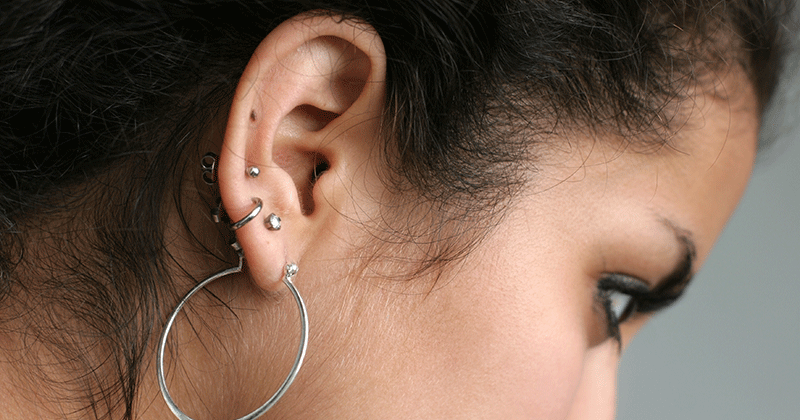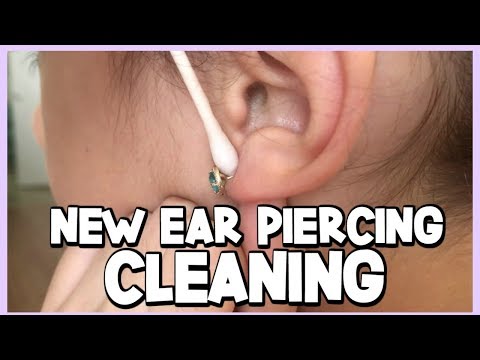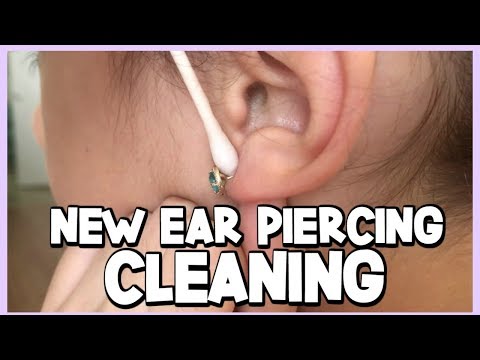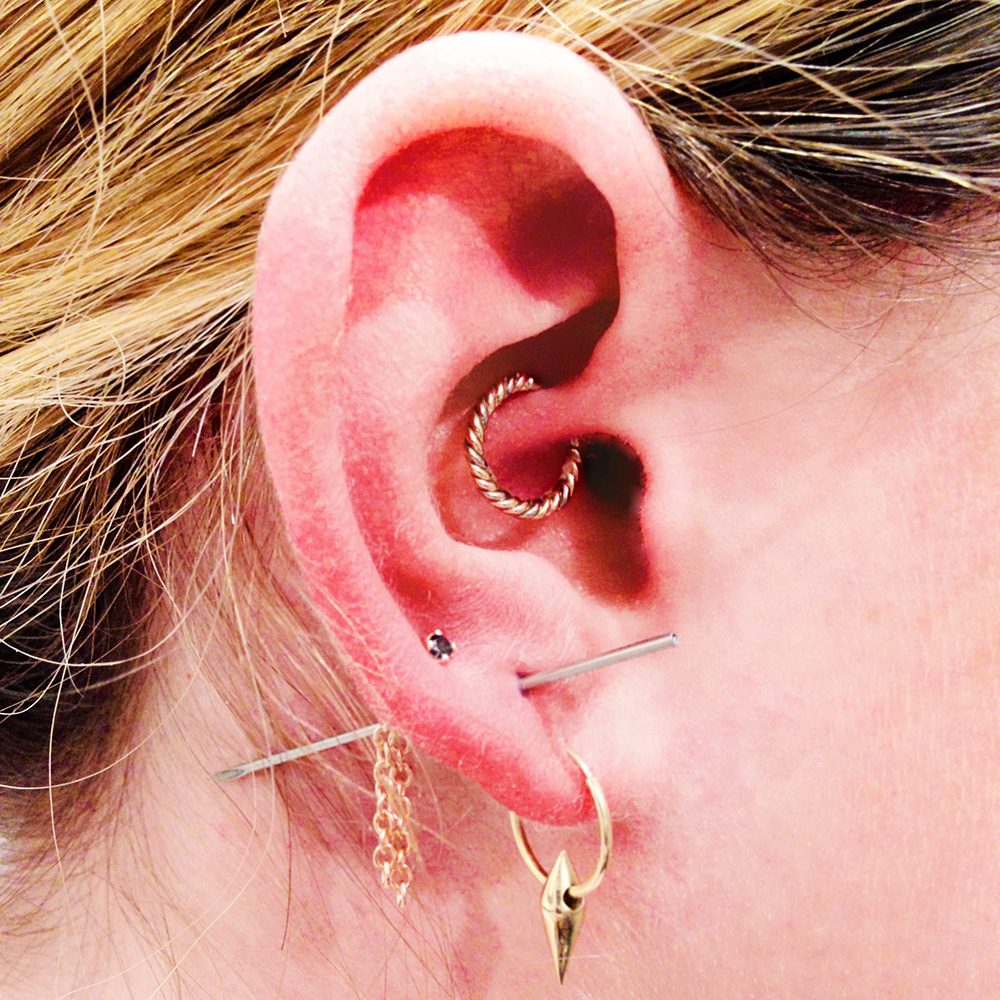Are you curious about how to properly care for a new ear piercing? Look no further! Centre of Wellness has got you covered with their informative Beauty Training Courses. From essential tips to best practices, you’ll learn everything you need to know about keeping your new ear piercing clean and healthy. With their online courses, you can conveniently access this valuable knowledge and ensure a successful healing process for your latest accessory. So say goodbye to any worries and start enjoying your newly pierced ears!

This image is property of www.jewelersmutual.com.
Cleaning the Piercing
How often should I clean my new ear piercing?
Cleaning your new ear piercing is crucial for preventing infection and promoting proper healing. It’s recommended to clean your piercing twice a day, in the morning and before bed, for the first few weeks. After that, you can reduce the frequency to once a day, but continue cleaning it until it is fully healed.
What should I use to clean my new ear piercing?
To clean your new ear piercing, you should use a saline solution or a sea salt solution. These solutions can be easily prepared at home by mixing 1/4 teaspoon of non-iodized sea salt with 8 ounces of warm distilled water. Avoid using alcohol, hydrogen peroxide, or any harsh chemical solutions as they can irritate the piercing.
How do I clean my new ear piercing?
To clean your new ear piercing, follow these steps:
- Wash your hands thoroughly with antibacterial soap before touching your piercing.
- Soak a cotton ball or cotton swab in the saline solution or sea salt solution.
- Gently clean around the piercing, removing any crust or discharge. Be careful not to twist or move the earring too much.
- Avoid using excessive force or rubbing, as it can cause irritation.
- After cleaning, rinse the piercing with warm water to remove any residue.
- Pat dry with a clean, disposable paper towel or let it air dry.
Remember to always handle your piercing with clean hands, and avoid touching it throughout the day, as it can introduce bacteria and prolong the healing process.
Should I rotate my earring while cleaning?
Contrary to popular belief, rotating the earring while cleaning is not necessary and can actually cause harm to your piercing. Rotating the earring can disrupt the healing process and create friction, leading to irritation or even infection. It’s best to leave the earring in place and avoid touching it unless you’re cleaning it.
Avoiding Irritation and Infection
How can I prevent irritation and infection?
Proper aftercare practices are essential for avoiding irritation and infection. Here are some tips to prevent these complications:
- Avoid touching or playing with the piercing unnecessarily.
- Always keep your hands clean before touching the piercing.
- Avoid swimming in pools, hot tubs, or bodies of water during the initial healing period.
- Avoid using harsh soaps, shampoos, or hair products near the piercing.
- Be cautious when styling your hair to prevent the earring from getting caught.
- Avoid sleeping on the side of the pierced ear to prevent irritation.
What activities and products should I avoid?
During the healing process, it’s important to avoid activities and products that can increase the risk of infection or irritation. Some activities and products to avoid include:
- Swimming in pools, hot tubs, lakes, or the ocean.
- Using hydrogen peroxide, alcohol, or any harsh cleansers on the piercing.
- Applying creams, lotions, or ointments to the piercing.
- Using headphones or earbuds for extended periods, especially if they apply pressure to the piercing.
- Exposing the piercing to excessive heat, such as sunbathing or tanning beds.
- Wearing hats or helmets that can rub against the piercing.
How long should I avoid swimming?
It’s best to avoid swimming in pools, hot tubs, lakes, or the ocean for at least six to eight weeks after getting your ear pierced. These bodies of water can contain bacteria and other microorganisms that can easily infect a healing piercing. Soaking your piercing before it’s fully healed can lead to complications and prolong the healing process.
What signs of infection should I look out for?
While it’s normal to experience some mild redness, swelling, and tenderness during the initial healing period, it’s important to be aware of the signs of infection. If you notice any of the following symptoms, it’s advisable to seek medical attention:
- Excessive swelling, redness, or warmth around the piercing site.
- Increasing pain that doesn’t improve with time.
- Pus or yellowish discharge coming from the piercing.
- A strong and unpleasant odor coming from the piercing.
- Development of a fever or chills.
If you suspect an infection, it’s crucial to seek prompt medical attention to prevent further complications.
Managing Discomfort and Swelling
Is it normal to feel discomfort after getting an ear piercing?
Yes, it is completely normal to experience some discomfort after getting an ear piercing. The initial pain or soreness should subside within a few days, but it’s not uncommon to feel some discomfort during the healing process. If the pain becomes severe or persistent, it’s best to consult with a healthcare professional.
How can I reduce swelling?
To reduce swelling after getting an ear piercing, you can follow these tips:
- Apply a cold compress or ice pack wrapped in a clean cloth to the pierced area for 15 minutes at a time.
- Take over-the-counter anti-inflammatory medication, such as ibuprofen, as directed by a healthcare professional.
- Avoid excessive touching or manipulation of the piercing, as it can aggravate the swelling.
- Avoid sleeping on the side of the pierced ear, as it can increase swelling and discomfort.
If the swelling worsens or persists for an extended period, it’s advisable to seek medical advice.
Should I take over-the-counter pain medication?
If you’re experiencing discomfort or pain after getting an ear piercing, it’s generally safe to take over-the-counter pain medication, such as ibuprofen or acetaminophen. However, it’s recommended to consult with a healthcare professional or follow the instructions on the medication packaging to ensure proper dosage and usage.
When should I seek medical attention?
While some discomfort and swelling are expected during the healing process, there are certain situations where seeking medical attention is necessary. It’s important to reach out to a healthcare professional if you experience any of the following:
- Severe or worsening pain that doesn’t improve with time.
- Excessive swelling or redness that lasts for an extended period.
- Pus or discharge that continues or increases.
- Development of a fever or chills.
- Allergic reaction symptoms, such as hives, rash, or difficulty breathing.
Your healthcare professional will be able to assess the situation and provide appropriate advice or treatment.
Choosing the Right Jewelry
What type of jewelry is best for a new ear piercing?
When it comes to choosing jewelry for a new ear piercing, it’s important to opt for materials that are hypoallergenic and suitable for healing piercings. Surgical stainless steel, titanium, and 14-karat or higher solid gold are excellent choices. Avoid using nickel-plated or low-quality jewelry, as they can cause allergic reactions and delay the healing process.
How often should I change my jewelry?
It’s recommended to keep the initial jewelry in place for at least six to eight weeks to allow proper healing. Changing the jewelry too soon can disrupt the healing process and increase the risk of infection. Once the piercing is fully healed, you can change the jewelry as desired.
When can I start wearing other earrings?
You can start wearing other earrings once your ear piercing is fully healed. This typically takes around six to eight weeks, but it can vary depending on your body’s healing process. It’s important to wait until the piercing is no longer tender, swollen, or showing any signs of infection before changing to other earrings.
Can I sleep with earrings in?
It is generally safe to sleep with earrings in once your ear piercing is fully healed. However, if you find discomfort or irritation from sleeping with earrings, you may prefer to remove them before bed. Be sure to thoroughly clean the earrings and piercing before reinserting them in the morning.

This image is property of invernesscorp.com.
Protecting the Piercing from Damage
How can I prevent the earring from getting caught or pulled?
To prevent your earring from getting caught or pulled, follow these precautions:
- Be mindful when changing clothes or removing clothing over your head to avoid getting the earring caught.
- Avoid brushing or combing your hair aggressively near the piercing.
- Be cautious while putting on or taking off hats, scarves, or other accessories that may come in contact with the earring.
- Take extra care when drying your hair with a towel to prevent snagging on the earring.
By being mindful of your movements and taking these steps, you can reduce the risk of damage to your piercing.
Should I cover my ear when styling my hair?
Covering your ear during the styling process can provide an extra layer of protection and prevent your hair from getting tangled or caught in the earring. You can use a hair clip or wrap a clean cloth around your ear to keep it out of the way while styling your hair. Just make sure the cloth or clip doesn’t put pressure on the piercing or cause irritation.
Can I wear headphones or earbuds?
It’s best to avoid wearing headphones or earbuds over the healing ear piercing, especially during the initial healing period. The pressure and friction from these devices can irritate the piercing and increase the risk of infection. If you must use headphones or earbuds, opt for ones that go around the ear or have a cushioned pad that doesn’t come in direct contact with the piercing.
What should I do if the earring gets snagged?
If the earring gets snagged or caught on something, try to remain calm and avoid pulling or tugging on it forcefully. Gently untangle the earring from whatever it’s caught on, and assess the piercing for any signs of damage or bleeding. If there are any concerns or if the piercing appears compromised, seek immediate medical attention for proper evaluation and care.
Healing Time and Aftercare
How long does it take for an ear piercing to heal?
The healing time for an ear piercing can vary depending on individual factors, such as the location of the piercing and your body’s healing ability. On average, ear piercings take about six to eight weeks to fully heal. However, cartilage piercings can take longer to heal, sometimes up to several months. It’s important to practice diligent aftercare until the piercing is completely healed.
What should I do if my piercing isn’t healing properly?
If your ear piercing isn’t healing properly, it’s crucial to assess the situation and take appropriate action. Here are some steps you can take:
- Ensure you’re following proper aftercare practices, such as cleaning the piercing regularly and avoiding irritants.
- Consult with your piercer or a healthcare professional to evaluate the piercing and determine if any additional treatment is required.
- Avoid changing or removing the jewelry prematurely, as this can disrupt the healing process.
In some cases, a non-healing piercing may need to be removed or treated by a healthcare professional to prevent further complications.
Should I continue cleaning the piercing after it has healed?
Once your ear piercing has fully healed, you can gradually reduce the frequency of cleaning. While it’s not necessary to clean it as frequently, it’s still important to maintain good hygiene and occasionally clean the piercing to remove any buildup or debris. Clean the piercing with a saline solution or mild soap and water whenever you feel it’s necessary.
Are there any long-term care considerations?
After your ear piercing has healed, there are a few long-term care considerations to keep in mind:
- Regularly inspect your piercing for any signs of irritation or infection, especially if you change the jewelry.
- Clean your earrings regularly to prevent buildup or bacteria.
- Be mindful of any lifestyle factors, such as sports or activities that may put the piercing at risk of damage or infection.
By staying vigilant and taking care of your piercing, you can enjoy your new earrings for years to come.

This image is property of i.ytimg.com.
Professional Piercing Care
Should I seek professional advice for piercing care?
While you can follow general aftercare guidelines for ear piercings, seeking professional advice is always a good idea, especially if you have any concerns or complications. Professional piercers have extensive knowledge and experience in proper piercing care and can provide personalized advice tailored to your specific situation.
When should I go back to the piercing studio?
It’s recommended to visit the piercing studio for a check-up appointment within the first few weeks after getting your ear pierced. During this appointment, the piercer can assess the healing progress, answer any questions or concerns you may have, and provide any necessary adjustments or advice. If you notice any issues or have questions later on, don’t hesitate to reach out to the piercing studio for guidance.
Can I remove my earring for cleaning?
Unless otherwise advised by a healthcare professional, it’s generally not recommended to remove the earring for cleaning, especially during the initial healing period. Removing the earring can disrupt the healing process and increase the risk of infection. If you feel the need to clean the jewelry itself, you can use a sterilized cotton swab or cotton ball dampened with a saline solution to gently clean around the earring without removing it.
What should I do if I experience excessive bleeding or pus?
Excessive bleeding or the presence of pus is not normal and could indicate an infection or other complications. If you experience these symptoms, it’s important to seek medical attention immediately. A healthcare professional can evaluate the situation, provide appropriate treatment, and guide you through the necessary steps to ensure proper healing.
Diet and Lifestyle Considerations
Does my diet affect the healing process?
While diet alone may not directly affect the healing process of an ear piercing, maintaining a healthy, balanced diet can contribute to overall skin health and support the body’s healing ability. Ensure you’re consuming a nutritious diet rich in vitamins, minerals, and antioxidants that promote skin health. Stay hydrated and avoid excess alcohol and tobacco consumption, as they can impair the healing process.
Should I avoid certain activities during healing?
During the healing period, it’s advisable to avoid certain activities that can increase the risk of irritation or damage to the piercing. These activities include:
- Playing contact sports or engaging in activities that may result in trauma to the piercing area.
- Exposing the piercing to extreme temperatures, such as hot tubs, saunas, or ice baths.
- Wearing tight or restrictive clothing that can rub against the piercing.
- Applying excessive pressure or tension to the piercing, such as with tight headbands or helmets.
By being mindful of these activities and taking necessary precautions, you can optimize the healing process.
Can I drink alcohol or smoke with a new ear piercing?
It’s generally recommended to avoid alcohol and smoking during the healing process of an ear piercing. Alcohol consumption can impair the body’s healing ability, while smoking introduces toxins into the body and hinders the healing process. Both alcohol and smoking can increase the risk of infection, delay healing, and compromise the overall health of the skin. It’s best to prioritize your healing process and minimize these habits during this time.
What other lifestyle factors should I consider?
In addition to diet, activities, and habits, there are other lifestyle factors to consider when caring for a new ear piercing:
- Stress levels: High stress levels can contribute to delayed healing. Try to manage your stress through relaxation techniques or engaging in activities that promote well-being.
- Sleep position: Sleeping on the side of the new piercing can increase pressure and friction, causing discomfort and potential problems. Consider adjusting your sleep position to avoid putting direct pressure on the piercing.
- Sun exposure: Excessive sun exposure can cause discoloration or damage to the healing piercing. Protect the area from direct sunlight by using sunscreen or covering it with clothing when spending time outdoors.
By considering these lifestyle factors and making adjustments as needed, you can support the healing process and promote optimal results.
This image is property of images.ctfassets.net.
Tips for Proper Aftercare
Keep the piercing clean and dry
Maintaining proper hygiene is crucial for the healing process of your ear piercing. Clean the piercing regularly as advised, and ensure it stays dry throughout the day. Moisture can create an environment for bacterial growth and delay the healing process. It’s also important to dry your ears gently after showering or any water exposure to prevent any excess moisture from accumulating.
Avoid touching the piercing with dirty hands
Avoid touching the piercing without washing your hands first, as bacteria and dirt on your hands can introduce infections. Always wash your hands thoroughly with antibacterial soap before cleaning or handling the piercing. If you need to touch the piercing, make sure your hands are clean and dry.
Be gentle when cleaning and drying the area
When cleaning or drying the pierced area, always be gentle to avoid causing further irritation or damage. Use a clean, disposable paper towel or sterile gauze to gently dab the area dry. Avoid rubbing or applying excessive pressure, as it can disrupt the healing process and delay recovery.
Follow any additional aftercare instructions provided by the piercer
Every individual and ear piercing is unique, so it’s important to follow any specific aftercare instructions provided by your piercer. They may have additional advice tailored to your situation or specific jewelry recommendations. By following their guidance, you can ensure the best possible outcome for your new ear piercing.
When to Seek Medical Attention
Excessive redness, swelling, or pain
While mild redness, swelling, and pain are expected during the healing process, excessive or worsening symptoms may indicate an issue. If the redness, swelling, or pain does not improve or becomes increasingly severe, it’s advisable to seek medical attention. A healthcare professional can assess the situation and determine the appropriate course of action.
Development of a fever
The development of a fever, especially when accompanied by other signs of infection, can be a cause for concern. Fever is the body’s response to an infection, and it should not be ignored. If you experience a fever along with other symptoms such as increasing pain, pus, or redness, seek immediate medical attention.
Discharge of pus
If you notice any discharge of pus from the piercing site, it could indicate an infection. Pus is a sign that the body is fighting off bacteria or other foreign substances. It’s crucial to seek medical attention if you observe any pus coming from the piercing, as it may require antibiotic treatment.
Signs of allergy or adverse reaction to jewelry
If you experience signs of an allergic reaction, such as hives, rash, itching, or difficulty breathing, it could be due to an allergy or adverse reaction to the jewelry. Allergic reactions can range from mild to severe, and in severe cases, they can be life-threatening. If you suspect an allergic reaction, seek immediate medical attention for appropriate evaluation and treatment.
Remember, if you have any concerns or questions about your ear piercing’s healing process, it’s always best to consult with a healthcare professional or your piercer for personalized advice and guidance. Your well-being and the proper healing of your piercing should be the top priority.



